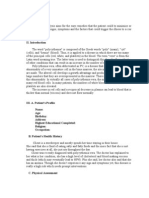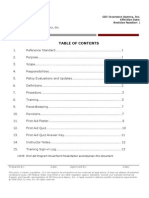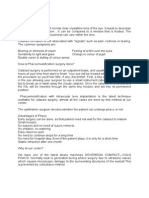Hematocrit Anemia
Hematocrit Anemia
Uploaded by
doppler_Copyright:
Available Formats
Hematocrit Anemia
Hematocrit Anemia
Uploaded by
doppler_Copyright
Available Formats
Share this document
Did you find this document useful?
Is this content inappropriate?
Copyright:
Available Formats
Hematocrit Anemia
Hematocrit Anemia
Uploaded by
doppler_Copyright:
Available Formats
Blood Donor Information
Thank you for coming to donate blood. We are Did you know that some causes
sorry that we cannot accept you as a donor today of anemia are invisible?
because your hematocrit level was too low. You may not know you have bleeding from
We care about your health and want to help you your digestive tract. This can be a result of:
understand what having a low hematocrit level
means.You are not alone, having a low hematocrit • Stomach ulcers
level is the most frequent cause for not being able • Growths in intestines (polyps)
to donate blood. You may return to donate when • Colon cancer
your hematocrit level has increased and you can • Certain medications
help immediately by asking your friends, family • Other diseases of the digestive tract
and/or coworkers to donate. There are several Anemia is often the first symptom of these
simple ways to improve your hematocrit level. conditions so it should be taken seriously. If you feel
You may be eligible to donate another time. you don’t fit in any of the previous categories,
What is Hematocrit? or just want to rule out these possibilities, make an
appointment with your physician without delay.
Blood is made up of red blood cells, white blood cells,
platelets, and plasma. Hematocrit is the percentage of blood You should see your doctor if your
volume that is red blood cells. Red blood cells contain hematocrit is low and you:
hemoglobin which carries oxygen to all the cells in the body.
• donate less than three times per year,
Why do we test potential blood
• are a non-menstruating woman of any
donors for hematocrit levels?
age with a hematocrit below 36%,
Hematocrit is measured prior to each donation as part of
• a man with a hematocrit less than 38%, and
donor screening. According to U.S. Food and Drug
Administration (FDA), hematocrit must be at least 38% for a • are not already under the care of a physician
donor to be able to donate blood for another person. The for one of the conditions listed above.
purpose of having a cut-off for minimal acceptable hematocrit
What can I do to increase
is to protect donors from becoming anemic (meaning their red
blood cell levels are lower than normal) from donating blood. my low hematocrit?
Increasing the consumption of red meat (liver in
What are the most common causes particular), fish and shellfish (oysters, clams, shrimp,
of low hematocrit and anemia? and scallops), dried fruit (apricots, prunes, and peaches),
• Iron deficiency from a low-iron diet green leafy vegetables, beans, iron fortified breads and
• Iron deficiency from frequent blood donation cereals, all rich in iron, may help. Furthermore, eating
(3 or more times per year) foods rich in vitamin C (citrus fruits, broccoli and
• Iron deficiency from menstrual blood loss tomatoes) helps in iron absorption.
• Vitamin deficiency from a diet low in folate, vitamin B6 or B12
Some foods block the absorption of iron, like coffee,
If your low hematocrit or anemia is caused by any of the
tea, milk, fiber, and soy protein. Avoiding such foods
conditions listed above, eating a diet high in iron rich foods and
taking a daily vitamin and iron supplement may help you raise would enable more iron from the diet and/or iron
your hematocrit. A call to your healthcare professional for further supplements to be absorbed. Lastly, over the counter
guidance may be advisable. iron supplements are readily available. The most common
side effect of these supplements is upset stomach.
What are other common causes of anemia? However, because multiple other causes of low hematocrit
Chronic illness such as: are also possible, donors may want to see their doctors
• Arthritis to determine the exact cause of low hematocrit before
• Diabetes taking iron pills or vitamins with iron.
• Kidney Disease
You should be under the care of a physician if you have
these conditions. Let your physician know about your low
hematocrit. He or she will work with you to find the best
treatment option for your particular needs.
June 2011
You might also like
- Organizing Solutions For People With ADHD, 2nd Edition-Revised and UpdatedDocument221 pagesOrganizing Solutions For People With ADHD, 2nd Edition-Revised and Updateddoppler_94% (53)
- Music Theory - From Beginner To Expert - The Ultimate Step-By-Step Guide To Understanding and Learning Music Theory Effortlessly (Essential Learning Tools For Musicians Book 1)Document145 pagesMusic Theory - From Beginner To Expert - The Ultimate Step-By-Step Guide To Understanding and Learning Music Theory Effortlessly (Essential Learning Tools For Musicians Book 1)doppler_95% (42)
- Music Theory - From Beginner To Expert - The Ultimate Step-By-Step Guide To Understanding and Learning Music Theory Effortlessly (Essential Learning Tools For Musicians Book 1)Document145 pagesMusic Theory - From Beginner To Expert - The Ultimate Step-By-Step Guide To Understanding and Learning Music Theory Effortlessly (Essential Learning Tools For Musicians Book 1)doppler_95% (42)
- The Personal Workbook For Breaking The Chain of Low Self-EsteemDocument308 pagesThe Personal Workbook For Breaking The Chain of Low Self-EsteemTim Dick100% (35)
- A Research About DepressionDocument36 pagesA Research About DepressionKeziah Ventura100% (1)
- A Case Analysis of Anemia2Document11 pagesA Case Analysis of Anemia2Recca Guirigay100% (1)
- PIL - What Is Anaemia (A5)Document8 pagesPIL - What Is Anaemia (A5)Hassan ShahNo ratings yet
- Anemia: Anurag B Patidar Lecturer, CON, DMCHDocument27 pagesAnemia: Anurag B Patidar Lecturer, CON, DMCHpreet kaurNo ratings yet
- Anemia and Chronic Kidney Disease: What You Need To Know AboutDocument8 pagesAnemia and Chronic Kidney Disease: What You Need To Know AboutyehezkieldwardNo ratings yet
- What Is Hyperkalemia (High Potassium) ?: HeartDocument2 pagesWhat Is Hyperkalemia (High Potassium) ?: HeartSebastian BujorNo ratings yet
- Advantages of Blood DonationDocument6 pagesAdvantages of Blood DonationMAHESH KOUJALAGINo ratings yet
- AnaemiaDocument32 pagesAnaemiafalodun miracleNo ratings yet
- 1 - Non Neoplastic AnemiaDocument16 pages1 - Non Neoplastic AnemiaMark Nicholz SimporiosNo ratings yet
- Anemia Treatment & DiagnosisDocument7 pagesAnemia Treatment & Diagnosis5z4w285jbfNo ratings yet
- Anemia and Treatment: By: Ms - HutchinsonDocument7 pagesAnemia and Treatment: By: Ms - HutchinsonqwankyoNo ratings yet
- What Is Anemia?Document7 pagesWhat Is Anemia?Monica Roly VonitaNo ratings yet
- Essential ThrombocythemiaDocument3 pagesEssential ThrombocythemiaJamal Anwar TahaNo ratings yet
- Anaemia PDFDocument3 pagesAnaemia PDFrian hadiNo ratings yet
- AnemiaDocument20 pagesAnemiaJane ColeNo ratings yet
- AscoleDocument2 pagesAscolemarthooNo ratings yet
- Transfusion of Blood Products: Commonly Asked QuestionsDocument3 pagesTransfusion of Blood Products: Commonly Asked QuestionsBenny TrisaktyariNo ratings yet
- How To Lower PlateletsDocument14 pagesHow To Lower PlateletsPerlitay OffemariaNo ratings yet
- Blood DonationDocument8 pagesBlood DonationSooraj KumarNo ratings yet
- PLATELET DONATION Sept2016 PDFDocument6 pagesPLATELET DONATION Sept2016 PDFsince k sajiNo ratings yet
- Know Which Vitamin Helps in Blood ClottingDocument11 pagesKnow Which Vitamin Helps in Blood ClottingGoranNo ratings yet
- Livng With CirrhosisDocument16 pagesLivng With CirrhosisN. Hansraj100% (1)
- Anemia and Chronic Kidney Disease: Stages 1-4Document16 pagesAnemia and Chronic Kidney Disease: Stages 1-4Pearl Raiza HadaniNo ratings yet
- Hemolytic AnemiaDocument6 pagesHemolytic AnemiaMaria Vernadette FloreceNo ratings yet
- Symptoms of Chronic Liver DiseaseDocument5 pagesSymptoms of Chronic Liver DiseaseAhmed HassanNo ratings yet
- Biology: Investigatory Project OnDocument24 pagesBiology: Investigatory Project OnManish KarnaniNo ratings yet
- AnemiaDocument2 pagesAnemiaLazeh MeNo ratings yet
- Anemia: Shannen Kate N. Tercenio PM401Document22 pagesAnemia: Shannen Kate N. Tercenio PM401Shannen Kate TercenioNo ratings yet
- Anemia: Anemia Caused by Blood LossDocument4 pagesAnemia: Anemia Caused by Blood LossColleen De la RosaNo ratings yet
- How To Increase Platelet Count in Natural WaysDocument15 pagesHow To Increase Platelet Count in Natural Waysshahkishan91No ratings yet
- Blood Clotting DisordersDocument2 pagesBlood Clotting DisordersPopi Bunga RopikohNo ratings yet
- AnemiaDocument11 pagesAnemiaapi-222411001No ratings yet
- Importance of Blood DonationDocument9 pagesImportance of Blood DonationJoseph KooNo ratings yet
- Why Get Tested?: AnaemiaDocument4 pagesWhy Get Tested?: Anaemiashasha009No ratings yet
- Anemia PPT - KeyDocument16 pagesAnemia PPT - KeyAyman RehmanNo ratings yet
- ThalassemiaDocument24 pagesThalassemiaanimesh panda100% (1)
- Understanding Your Lab Values - National Kidney FoundationDocument2 pagesUnderstanding Your Lab Values - National Kidney FoundationjohnsonkkuriakoseNo ratings yet
- Princess Durru Shehvar College of Nursing B.SC Nursing 2 Year Online Coaching Community Health Nursing - I AnemiaDocument6 pagesPrincess Durru Shehvar College of Nursing B.SC Nursing 2 Year Online Coaching Community Health Nursing - I AnemiaAnonymous hYMWbA100% (1)
- Inf1268 3 Feb 2021 Anaemia Patient InformationDocument5 pagesInf1268 3 Feb 2021 Anaemia Patient InformationDavis JermacansNo ratings yet
- Fatigue: What Is Anemia?Document3 pagesFatigue: What Is Anemia?Annapurna DangetiNo ratings yet
- Your Liver-It Is Amazing and EssentialDocument5 pagesYour Liver-It Is Amazing and Essentialsudha_karNo ratings yet
- HCA 240 WK 4 Blood DisordersDocument6 pagesHCA 240 WK 4 Blood Disordersmarilyn1221_55503248No ratings yet
- Iron Deficiency AnemiaDocument5 pagesIron Deficiency AnemiaHRCNo ratings yet
- Polycythemia Vera CompletedDocument5 pagesPolycythemia Vera CompletedSaro BalberanNo ratings yet
- AnemiaDocument16 pagesAnemiaAbdelrahman Faiesal MohamedNo ratings yet
- Pernicious Anaemia and B12 2020Document42 pagesPernicious Anaemia and B12 2020viraaj pawarNo ratings yet
- ThalassemiaDocument3 pagesThalassemiaHENG OSBORNNo ratings yet
- Anemia: Arranged By: Mishael Immanuel Dae Pany (2014.03.010) Firman Syalasah (2014.03.006)Document13 pagesAnemia: Arranged By: Mishael Immanuel Dae Pany (2014.03.010) Firman Syalasah (2014.03.006)kharisma restuNo ratings yet
- Approach To Anemia: Bisrat DDocument45 pagesApproach To Anemia: Bisrat Dyared getachewNo ratings yet
- AnemiaDocument5 pagesAnemiaSt. MatthewGalnayonMa. Alyza KaeNo ratings yet
- For Post: For Doc Who Can/can't Donate Blood? CanDocument5 pagesFor Post: For Doc Who Can/can't Donate Blood? Canvidyasri19No ratings yet
- Anemia 090820015524 Phpapp01Document31 pagesAnemia 090820015524 Phpapp01Jeffrey Calicdan BucalaNo ratings yet
- What Is High Blood Pressure?: HeartDocument2 pagesWhat Is High Blood Pressure?: HeartSivaram MuthuswamiNo ratings yet
- All About Blood TestsDocument12 pagesAll About Blood TestsAzael RojasNo ratings yet
- Hematologic DisorderDocument66 pagesHematologic DisorderKristel AnneNo ratings yet
- What Is Metabolic Syndrome?: HeartDocument2 pagesWhat Is Metabolic Syndrome?: HeartSebastian BujorNo ratings yet
- Importance of Blood Donation in Daily LifeDocument12 pagesImportance of Blood Donation in Daily LifeJust A normal UserNo ratings yet
- Cure Diseases Naturally at Home: Low Platelets Count Home RemediesDocument5 pagesCure Diseases Naturally at Home: Low Platelets Count Home Remediesvipra ayurvedaNo ratings yet
- Blood DonationDocument19 pagesBlood Donationsundesh4100% (1)
- The Complete Guide on Anemia: Learn Anemia Symptoms, Anemia Causes, and Anemia Treatments. Anemia types covered in full details: Iron-deficiency, Microcytic, Autoimmune Hemolytic, Sideroblastic, and Normocytic AnemiaFrom EverandThe Complete Guide on Anemia: Learn Anemia Symptoms, Anemia Causes, and Anemia Treatments. Anemia types covered in full details: Iron-deficiency, Microcytic, Autoimmune Hemolytic, Sideroblastic, and Normocytic AnemiaRating: 3.5 out of 5 stars3.5/5 (10)
- High Platelets, (Thrombocythemia) A Simple Guide To The Condition, Diagnosis, Treatment And Related ConditionsFrom EverandHigh Platelets, (Thrombocythemia) A Simple Guide To The Condition, Diagnosis, Treatment And Related ConditionsNo ratings yet
- Dairy: Veggies: Eggs, Meats, Seafood, Meat Substitutes: Fruits: GrainsDocument1 pageDairy: Veggies: Eggs, Meats, Seafood, Meat Substitutes: Fruits: Grainsdoppler_No ratings yet
- Noom Green FoodsDocument1 pageNoom Green Foodsdoppler_100% (1)
- Cos Derm Do Not Copy: The Skin Moisturizer Debate: Oil or Oil-Free?Document2 pagesCos Derm Do Not Copy: The Skin Moisturizer Debate: Oil or Oil-Free?doppler_No ratings yet
- Noom Yellow FoodsDocument1 pageNoom Yellow Foodsdoppler_No ratings yet
- IUD Take-Home Sheet: XXXXXX Health CenterDocument1 pageIUD Take-Home Sheet: XXXXXX Health Centerdoppler_No ratings yet
- The Pictorial Key To The Tarot (Illustrated)Document125 pagesThe Pictorial Key To The Tarot (Illustrated)doppler_83% (6)
- Anna List: Bachelor of Business AdministrationDocument1 pageAnna List: Bachelor of Business Administrationdoppler_No ratings yet
- Science Pre Health Resume SampleDocument1 pageScience Pre Health Resume Sampledoppler_No ratings yet
- Treating Comorbid PTSD and BPDDocument52 pagesTreating Comorbid PTSD and BPDdoppler_No ratings yet
- Resume and Cover Letter Guide: Apply DifferentlyDocument11 pagesResume and Cover Letter Guide: Apply Differentlydoppler_100% (2)
- Hdpvr2: Models 1512, 1514 and 1507Document2 pagesHdpvr2: Models 1512, 1514 and 1507doppler_No ratings yet
- ADHD Executive Dysfunction Strategies For Kids Teens - Some Thoughts On Task InitiationDocument7 pagesADHD Executive Dysfunction Strategies For Kids Teens - Some Thoughts On Task Initiationdoppler_No ratings yet
- Sanrio Calendar January 2021Document1 pageSanrio Calendar January 2021doppler_No ratings yet
- Marble Cake RecipeDocument1 pageMarble Cake Recipedoppler_No ratings yet
- Yakima Medical ConsultDocument7 pagesYakima Medical ConsultBikash G MainaliNo ratings yet
- The WandererDocument17 pagesThe WandererFelipe Figueiredo100% (5)
- First Aid Program OSHA Compliant From GDIDocument14 pagesFirst Aid Program OSHA Compliant From GDIGrant Davis100% (2)
- Encyclopedia of Behavioral Medicine 2013Document103 pagesEncyclopedia of Behavioral Medicine 2013Filsa Putri AnwarNo ratings yet
- Dr. Kasthuri Bai P.CDocument44 pagesDr. Kasthuri Bai P.CNeeraja KurupNo ratings yet
- Common Dental ProblemsDocument14 pagesCommon Dental ProblemsInternational Journal of Innovative Science and Research TechnologyNo ratings yet
- Nerves of Lower Limb and Their Injuries: Learning ObjectivesDocument8 pagesNerves of Lower Limb and Their Injuries: Learning ObjectivesUloko ChristopherNo ratings yet
- Nifedi-Denk 20 Retard - Nifedipine 20mg Prolonged Release Tablet - PILDocument2 pagesNifedi-Denk 20 Retard - Nifedipine 20mg Prolonged Release Tablet - PILHamadou FadimatouNo ratings yet
- Chest Wall DeformitiesDocument25 pagesChest Wall DeformitiesRaghu Nadh100% (1)
- Drugs Used in PregnancyDocument11 pagesDrugs Used in PregnancyTasmia RhamanNo ratings yet
- Fisio - Faal Special SenseDocument107 pagesFisio - Faal Special SensetiffsbronteNo ratings yet
- Genetics and Biotechnology Reaction PaperDocument2 pagesGenetics and Biotechnology Reaction PaperARLENE POMBONo ratings yet
- Neurosurgery Cases and Reviews NCR 3 046Document4 pagesNeurosurgery Cases and Reviews NCR 3 046Nurhaini Safaul Marwa RimosanNo ratings yet
- Shock AssignmentDocument6 pagesShock Assignmentareebafarooq820No ratings yet
- Medical Physics Course Notes (Greg Pitt)Document92 pagesMedical Physics Course Notes (Greg Pitt)Mel ClancyNo ratings yet
- NCP MeningitisDocument2 pagesNCP MeningitisARISNo ratings yet
- 1683personalhygiene WorksheetDocument6 pages1683personalhygiene Worksheetramzan aliNo ratings yet
- Respiratory and Cardiovascular Drugs TestDocument10 pagesRespiratory and Cardiovascular Drugs TestMaria Chrislyn Marcos GenorgaNo ratings yet
- Ngeh 2006Document5 pagesNgeh 2006ayu fitriaNo ratings yet
- Cataract SurgeryDocument9 pagesCataract SurgerygandikotavtpsNo ratings yet
- Career of NurseDocument8 pagesCareer of NurseMhamad OmerNo ratings yet
- Care Sheet - Asian Leaf Turtle (Cyclemys Dentata)Document3 pagesCare Sheet - Asian Leaf Turtle (Cyclemys Dentata)John GamesbyNo ratings yet
- MCQ FMS 4 (2016) With AnswersDocument13 pagesMCQ FMS 4 (2016) With Answersstella pangestikaNo ratings yet
- Quarter 4 Module General Biology 2Document34 pagesQuarter 4 Module General Biology 2Louise L.No ratings yet
- Merrill 2017Document18 pagesMerrill 2017Duy PhạmNo ratings yet
- Prognosis Pneumonia PDFDocument18 pagesPrognosis Pneumonia PDFamania jeumpa nur alamNo ratings yet
- W3-19 Operative Obstetrics - LectureDocument72 pagesW3-19 Operative Obstetrics - LectureRanjit SharmaNo ratings yet
- MT3 Module-Week-1-12Document46 pagesMT3 Module-Week-1-12chloe annNo ratings yet
- Imunitas AdaptifDocument55 pagesImunitas AdaptifjagoanpremiumNo ratings yet










































































































